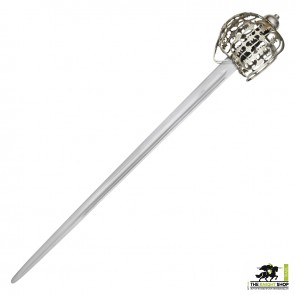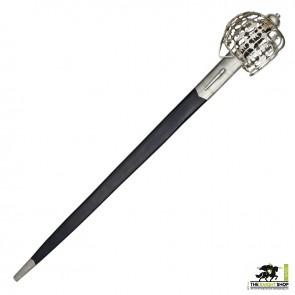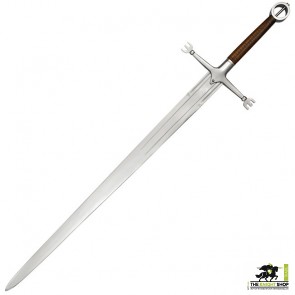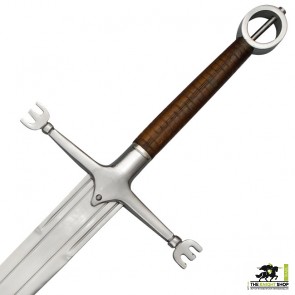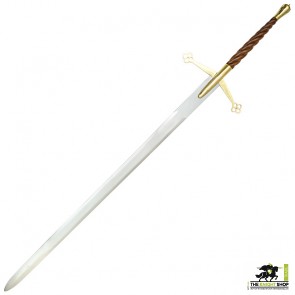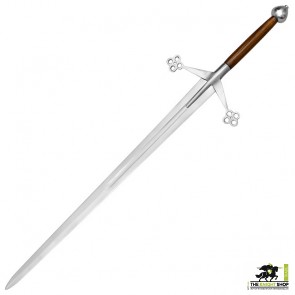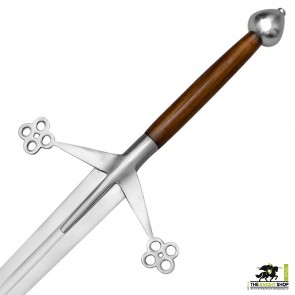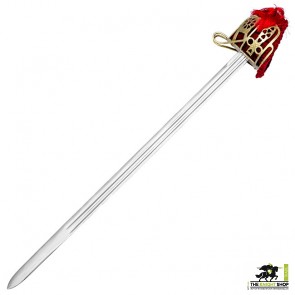Scottish Swords
-
Scottish Highland Officer's Broadsword
Step back in time and wield a piece of history with our meticulously crafted replica of the Eglinton “Pinch of Snuff” Scottish Highland Officer’s Broadsword. This elegant broadsword, inspired by an original from the early 19th century, epitomizes the distinctive style and valor of the Scottish Highland officers who carried it.
Learn More
Deepeeka’s replica features an authentic basket hilt design, complete with intricate steelwork and a rich blackened leather grip that mirrors the original’s craftsmanship. The blade is forged from high-quality, tempered carbon steel, ensuring both durability and an impressive historical appearance. The sword’s guard is adorned with intricate scrollwork and pierced designs, enhancing its authenticity and making it a striking display piece or a functional addition to reenactments and costume events.
Total Length: 99cm
Blade Length: 82cm
Blade Width: 4cm
Guard Width: 14cm
Grip Length: 11cm
P.O.B (from guard): 11cm
Edge: Blunt
Weight: 1310g
All dimensions are approximate and may vary from piece to piece. -
William Wallace Braveheart Sword - Brass
Our William Wallace Braveheart Sword is inspired by the sword used in the film Braveheart.
Learn More
It is forged from high carbon steel and features a broad blade topped with solid brass hilt fittings and a brown suede ricasso and grip. This sword features a blunt blade and is designed for display only.
Total length: 136cm
Blade length: 97.5cm
Grip length: 28.6cm
Weight: 2.1kg
Blade width (base): 4.3cm
Point of Balance (PoB): 14cm
Blade: High Carbon Steel
Edge: Blunt
Pommel: Threaded
Scabbard: None
All dimensions are approximate and may vary from piece to piece. -
Gallowglass Sword
The word Gallowglass is an Anglicisation of the Irish word Gallóglaigh meaning “foreign soldiers”. They were mercenary warrior elite among Scottish clans living in the Highlands and Western Isles between the 13th and 16th century. During the 13th century they started to settle in Ireland where military chieftains would frequently use them as bodyguards as they were not subject to local feuds or influences.
Learn More
A description from 1600, speaks of the Gallowglass as "...pycked and scelected men of great and mightie bodies, crewell without compassion. The greatest force of the battell consisteth in them, chosing rather to dye than to yeelde, so that when yt cometh to handy blowes they are quickly slayne or win the fielde." They were famed for using their broadswords or claymores ("claíomh mór" - Gailic for “Great Sword”) with terrifying effect in battle.
Overall Length: 136cm
Blade Length: 104cm
Blade Width: 6.35cm
Blade Thickness: 0.6cm
Guard Width: 30cm
Guard Depth: 2.9cm
Grip Length: 18.5cm
Blade: High Carbon Steel
Edge: Blunt
Pommel: Peened
Scabbard: None
All dimensions are approximate and may vary from piece to piece. -
Twisted Hilt Scottish Claymore
The Claymore (from the Scottish Gaelic claidheamh-mòr, meaning “great sword”) is a Scottish variant of the late medieval 2 handed sword. It differed from other longswords of the period in that it usually had forward sloping quillons terminating in quatrefoils. Claymores were in use during constant clan warfare and fights with the English from the 15th to 17th century. Claymores did exist as early as the Wars of Scottish Independence although they were smaller and few had the characteristic quatrefoil design. The last time that claymores were seen on the battlefield in any significant number was the Battle of Killiecrankie in 1689.
Learn More
Our Twisted Hilt Scottish Claymore features a hand-forged high carbon steel blade topped with brass hilt fittings and a hand carved real wood grip. This sword has a blunt blade and is designed for display only.
Overall Length: 143cm
Blade Length: 106.5cm
Grip Length: 23cm
Weight: 2294g
Blade thickness (base): 0.5 cm
Blade width (base): 5 cm
Point of Balance (PoB): 19.5 cm
Blade: High Carbon Steel
Edge: Blunt
Pommel: Peened
Scabbard: None
All dimensions are approximate and may vary from piece to piece. -
Two Handed Scottish Claymore
The Claymore (from the Scottish Gaelic claidheamh-mòr, meaning “great sword”) is a Scottish variant of the late medieval 2 handed sword. It differed from other longswords of the period in that it usually had forward sloping quillons terminating in quatrefoils. Claymores were in use during constant clan warfare and fights with the English from the 15th to 17th century. Claymores did exist as early as the Wars of Scottish Independence although they were smaller and few had the characteristic quatrefoil design. The last time that claymores were seen on the battlefield in any significant number was the Battle of Killiecrankie in 1689.
Learn More
Our Two Handed Scottish Claymore has a hand-forged high carbon steel blade topped with solid steel hilt fittings and a stained real wood grip. This sword has a blunt blade and is designed for display only.
Overall Length:123cm
Blade Length: 92cm
Blade Width: 5.8cm
Blade Thickness: 0.5cm
Guard Width: 29cm
Guard Depth: 2.9cm
Grip Length: 19cm
Blade: High Carbon Steel
Edge: Blunt
Pommel: Peened
Scabbard: None
All dimensions are approximate and may vary from piece to piece. -
The Stirling Monument William Wallace Sword
The William Wallace Sword on display at the Stirling Monument, Scotland, is alleged to have been used by Wallace at the battles of Stirling Bridge and Falkirk. After his execution in 1305, the sword is alleged to have been sent to John de Menteith, governor of Dumbarton Castle. In 1505, accounts show that James IV of Scotland paid 26 shillings to an armourer for "binding of Wallace's sword with cords of silk" and fitting it with "a new hilt and plummet" – which would account for the 16th century style hilt. A “new scabbard and a new belt” was also purchased at that time. Legend tells that the original scabbard and belt were made from the dried skin of Hugh Cressingham, one of the English Commanders at the Battle of Stirling Bridge.
Learn More
Our William Wallace Sword is a replica of the one displayed at the Stirling Monument. It features a huge 136cm blade, the total length of the sword being an intimidating166cm! The 16th century style hilt fittings are made from solid steel and feature a leather-wrapped wooden grip. This impressive sword has a blunt blade and is designed for display only.
Please note: The extreme length of the forged blade means that it is too flexible for anything but display. The blade may also have imperfections such as a slight twist or curve (that wouldn’t be noticed when hanging on a wall unless you were looking for it). The original sword on display in the Sterling Monument, has a blade made from 3 separate swords welded together and is certainly not free from imperfections.
Overall Length: 166cm
Blade Length: 136cm
Blade Width: 5cm
Blade Thickness: 0.5cm
Guard Width: 28cm
Guard Depth: 15cm
Grip Length: 26cm
Weight: 2.6kg
Blade: High Carbon Steel
Edge: Blunt
Pommel: Threaded
Scabbard: None
All dimensions are approximate and may vary from piece to piece. -
Robert the Bruce Sword
The Robert the Bruce Sword features a forged steel blade with solid brass pommel and guard. The pommel features the rampant lion of the Bruce coat of arms whilst the guard is decorated with crusader crosses, both in red enamel. The leather and wood scabbard is decorated with a “Z” pattern and has brass scabbard loops.
Learn More
This sword is blunt and designed for display only.
Total length: 97 cm
Blade length: 78.5 cm
Grip length: 12.5 cm
Weight: 1140 g
Blade thickness (base): 0.44 cm
Blade width (base): 4.5 cm
Point of Balance (PoB): 13.5 cm
Blade: High Carbon Steel
Edge: Blunt
Pommel: Peened
Scabbard: Leather, Wood
All dimensions are approximate and may vary from piece to piece. -
Jacobite Basket Hilt Sword
The iconic Basket Hilt Sword was wielded by Jacobite warriors during the rebellions of 1715 and 1745. It was usually partnered with the Scottish targe shield and was used to devastating effect during the Highland Charge! After the rebellion had been suppressed, the wearing of Scottish Basket Hilt swords, synonymous with Highland dress, was outlawed. However, the sword was adopted by officers of the Highland regiments in the 19th century.
Learn More
Our Jacobite Basket Hilt Sword features a brass basket with red cloth lining. The hand forged high carbon steel blade has a blunt edge and is housed in a leather covered wood scabbard.
Total length: 106 cm
Blade length: 89 cm
Grip length: 11 cm
Weight: 1600 g
Blade thickness (base): 0.5 cm
Blade width (base): 3.6 cm
Point of Balance (PoB): 20cm
Blade: High Carbon Steel
Edge: Blunt
Pommel: Threaded
Scabbard: Leather, Wood, Brass
All dimensions are approximate and may vary from piece to piece.




